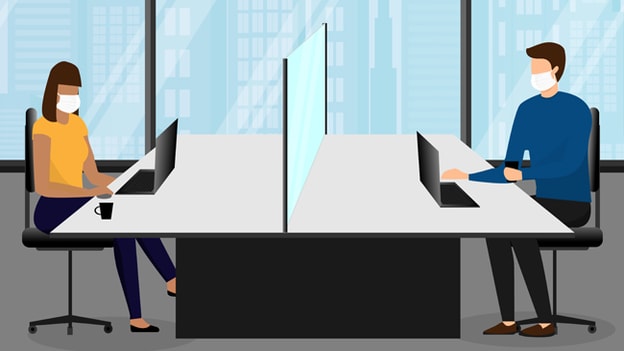As an employer it’s time to 'CARE'

As we start to reopen the economy, we’re all grappling with a mix of emotions. The positive is that we’re a step closer to “normalcy,” which might mean a firmer footing on the employment and financial front for many. On the other hand, with a treatment and cure still elusive, our anxiety levels are still on high alert. In these uncertain times corporate employers face a heavy burden to ensure a safe workplace while at the same time effectively managing the levers for maximizing productivity. To achieve that fine balance, the focus now can’t just be on physical safety but also needs to include mental health and the overall well-being of their employees.
Even before COVID-19 came into the picture India’s corporate workforce was already struggling with longer hours and high stress levels. An Optum study conducted in 2016 which included 200K employees across 30 large corporations had found that a staggering 46% of employees suffered from stress. The pandemic has tilted that balance for many more. Financial concerns, fear of job loss, increased isolation and a tougher work/life balance are just some of the issues that have raised anxiety levels. These struggles have begun to impact productivity with insufficient sleep, impaired concentration and an increase in addiction being some of the manifestations being talked about. Everyone is vulnerable and no one is immune.
As companies sweat the precautionary details to ensure physical safety, it’s time to delve into the details of mental safety as well. Employers should consider an encompassing approach and be mindful that the traditional return on investment metrics may not reveal the true benefit upfront. Consider the CARE approach to deliver a more resilient workforce in the long run.
CARE is an acronym for Communicate, Accommodate, Reintegrate and Empathize. Here are the salient aspects:
Communicate:
- Create a Mental Health and Well-being policy: Nothing clarifies where you stand as an employer more than having a clear, well documented policy on the matter. The best way to get there is to review best practices of other employers and then integrate those ideas with the thoughts of key stakeholders including senior management, employees, HR and a mental health professional. What is your position on working from home? Can employees take leaves for mental health? How do you plan on supporting employees with high stress or addictions? Pen down a list of such questions that are important to tackle and work through them. The document should articulate a cultural stand that is embraced from the CEO down, not just empty words that sound good.
- Be transparent and authentic, communicate often: Information is the lifeline for many employees who are trying to get comfortable with where the company is headed and where they stand. Authenticity in communicating the realities builds trust within the organization that helps everyone perform better.
Accommodate:
- Work from Home (WFH) accommodation: WFH is now well tested. It may not be for everyone and not for all the time but it’s an important option that can deliver high productivity. So, allow your employees to decide to WFH as needed - create guidelines that you’re comfortable with. Salesforce, as an example, is taking the unprecedented step of allowing all their 50k employees to work from home for the rest of 2020, if the employees so choose.
- Leave and work hours flexibility: Many companies have added additional leaves for the pandemic or provided extra time off. Time for employees to decompress, spend with family or whichever combination they choose. In addition, allowing flexible work hours would also help. Maybe it’s okay for some employees to start the day at 7:30am and end by 4pm. Shift from fixating on attendance to ensuring that things get done, helping both the company and the employee.
Reintegrate:
- Mental Health support: Resolve to provide the needed mental health support for employees to recuperate from stressors through awareness sessions on aspects like stress and anxiety management. For employees who need more, one on one therapy sessions would certainly help. Additionally, classes such as meditation, yoga, mindfulness, nutrition and fitness can aid employees in managing their stress. Not all need to be fully funded by the company. Even if you gather a set of resources that you can recommend to your employees it would be a step ahead.
- Training: Continuous learning was important before and is more so now. With a changed landscape demanding more creative solutions and better interpersonal management, equipping employees with the tools is imperative. Add training on a range of applicable areas including technology, decision making and soft skills, among others, for all your employees.
Empathize:
- Open doors, open minds: Creating an environment where employees are comfortable sharing their fears, challenges and hopes can go a long way in fostering resilience. HR and management should institute a formalised open-door policy that welcomes sharing and extends empathy. Employees too should be trained on how to check in with each other and provide comfort or referrals when they see someone struggling. Dupont, the chemicals giant, successfully implemented a novel “I See You” program across their 70k staff, globally. The program raised awareness and interventions to the benefit of the company greatly.
- Practice gratitude: Incorporating thankfulness and gratitude into the work culture has shown to increase positivity. That positivity can be infectious when practiced by everyone along the chain. Employee and colleague recognition are important motivators, whether through a kind word, a gesture or monetary rewards.
Whether, as a company, you choose to do all of these or some, the important thing is to start a discussion. Anne Mulcahy, the former CEO of Xerox, said it best, ”Employees who believe that management is concerned about them as a whole person – not just an employee – are more productive, more satisfied, more fulfilled. Satisfied employees mean satisfied customers, which leads to profitability.”
















